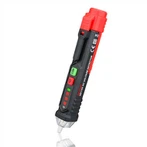1. Read the manual carefully before use to find out whether it is AC or AC and DC.
2. The voltage of the circuit under test cannot exceed the value indicated on the clamp meter, otherwise it is easy to cause a grounding accident or cause an electric shock hazard.
3. Only the current of one-phase wire can be measured at a time, the wire under test should be placed in the center of the clamp window, and multi-phase wires cannot be clamped into the window for measurement.
4. Before measuring the clamp meter, you should first estimate the magnitude of the measured current, and then decide which range to use. If it is impossible to estimate, you can use the maximum range first and then change it to a smaller one for accurate reading. Do not use small current gear to measure large current. to prevent damage to the instrument.
5. The jaws should be closed tightly during measurement. If there is noise after closing, the jaws can be opened and closed again. If the noise still cannot be eliminated, check whether the joint surfaces on the magnetic circuit are smooth and clean, and wipe clean when there is dust.
6. Due to the low accuracy of the clamp-type ammeter itself, when measuring small currents, the following method can be used: first, wind the wire of the circuit under test a few times, and then put it into the jaw of the clamp-type meter for measurement. At this time, the current value indicated by the clamp meter is not the actual value being measured. The actual current should be the reading of the clamp meter divided by the number of turns of the wire.
7. Do not operate with electricity during maintenance to prevent electric shock.
GVDA Digital Clamp meter GD112C:
Pls Clink Below Photo and Read more details about this GVDA Digital Clamp meter GD112C :






